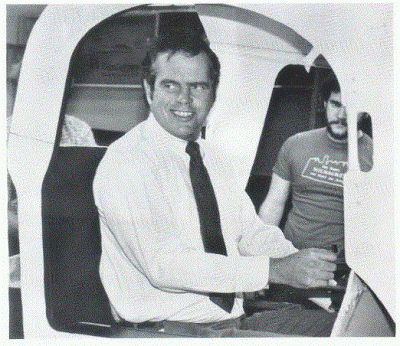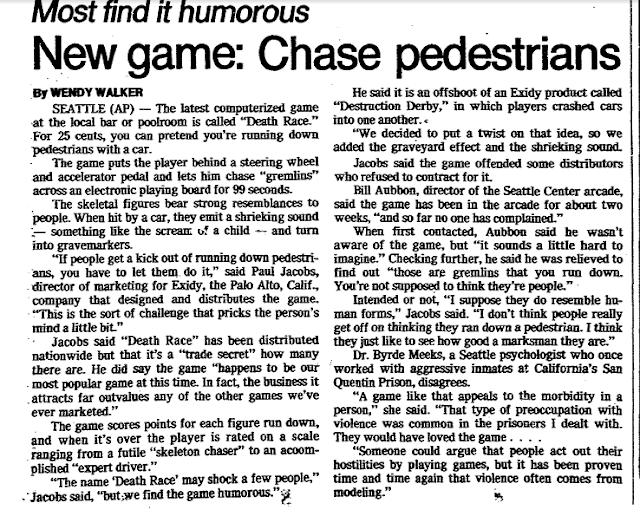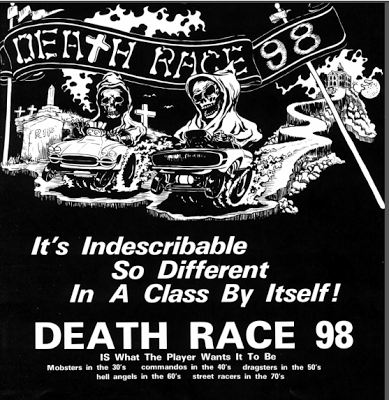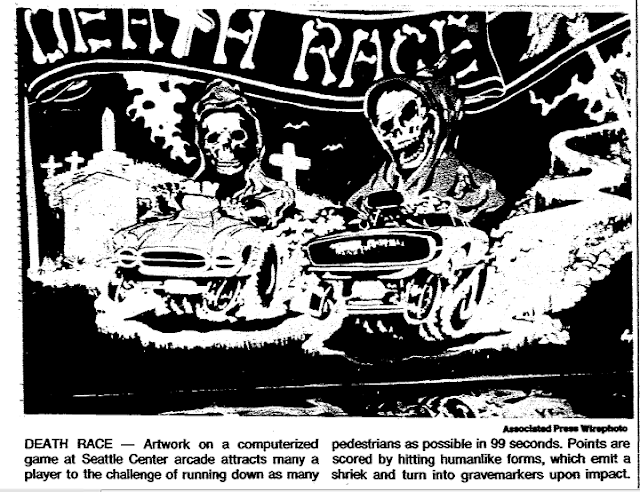 |
Exidy founder Pete Kaufmann |
In 1973, Kauffman left his job at Ramtek, where he had been a
founding partner, to start a new company of his own to design and manufacture
video games, which Kauffman was convinced were here to stay.
[Pete Kauffman] I was
really excited when I first saw this Pong game on test at a local pub. It was
assembled in an old oak barrel ‘table model’ without a coin door. The quarters
just dropped into the barrel. After playing the game, I tried to move it
slightly. It wouldn’t move. It must have been full of quarters. This could not
have been a fad![1]
Called Exidy (an abbreviation for Excellence In Dynamics) Kauffman’s new company was incorporated on October 30 with Kauffman as president and former Ampex engineer Samuel Hawes as vice president[2]. With just a single engineer (John Metzler from Ramtek), Kauffman set up shop in a cramped 1,200-square-foot facility on Middlefield Road in Palo Alto. With their funds almost as limited as their space, Exidy’s initial games were distributed only on the west coast. They started with Hockey/Tennis, a Pong clone that used cellophane overlays to produce the illusion of color (Larry Hutcherson remembers that the game was called Thumper Bumper), followed by a game called Sting[3]. Exidy’s first product to be distributed nationwide was 1974’s TV Pinball[4]. Billed as a video version of pinball, it was really just one of the more elaborate of the early ball-and-paddle games. The “playfield” included 16 “bumpers” that the player could eliminate for 100 points. Nine “pockets” (also worth 100 points) lined the top and sides and a moving target worth 2,000 points moved across the top of the screen. Sound was provided by an actual set of pinball chimes mounted inside the cabinet. The game provided Exidy with its first success, albeit a modest one[5]. In 1975, Exidy moved to larger facilities in Sunnyvale and in October they showed four games at the MOA show. Three were Pong games: TV Pinball, Table Pinball (the cocktail version of TV Pinball), and Table Foosballer and the fourth was a driving game called Destruction Derby.
During these early years, one of the company's
most pressing needs was staff, Pete Kauffman turned to whatever source he could
to recruit new workers. At the time, the company had only a dozen or so
employees and all of them had to work whenever and wherever they could in order
to get games ready for sale. Chicago Coin's Director of European Sales,
Paul Jacobs, signed on to head up Exidy’s marketing department in 1976. Jacobs
started his coin-op career riding shotgun on his father's American Coin Machine
route in the 1960s. In 1967 he went into sales for his United, Inc., a
distribution company also owned by his father. After graduating with a degree
in political science he became sales manager and then president of United until
it was bought by jukebox giant Wurlitzer. Jacobs had also worked for Rowe and
after leaving Exidy would go on to work for a more than a dozen coin-op
companies in his forty-year career. Artist Michael Cooper-Hart met Kauffman at
a Christmas party in 1975. At the time, Cooper-Hart was teaching design and
fine arts at De Anza College in Cupertino. When Kauffman asked him if he was
interested in working for a new company named Exidy, Cooper-Hart refused. He
considered himself and artist and artists simply didn’t do commercial work.
Kauffman’s powers of persuasion (and Cooper-Hart’s anemic bank account) eventually
overcame his reservations and he signed on as a consultant at Exidy, where he
would design many of the company’s classic game cabinets and go on to become
Director of Design (though at some point Cooper-Hart also worked at Atari's
Cyan Engineering think tank on a video phone). When he first arrived, however, he
was taken aback when he got a look at a new game the company was producing – a
driving game called Death Race.
Death Race
Released in April, 1976, Death Race was not Exidy’s first driving game – that honor goes to 1975’s Destruction Derby, itself a game unlike the host of other driving games on the market. While it had standard driving controls, the gameplay was anything but. Rather than a simple racing game Destruction Derby was a video version of the demolition derby in which a group of cars competed in an arena and tried to bash each other into pieces of useless wreckage. The last car that remained drivable was dubbed the “winner”.
Initially produced by
Exidy, the demand for Destruction Derby was so great (and
Exidy's capacity so small) that they had to devote their entire production line
to Destruction Derby and nothing
else. To free up production, they licensed the game to the floundering Chicago
Coin who produced the game as Demolition
Derby (they also licensed TV Pinball
to Chicago Coin, who produced it as TV
Pin Game). As part of the deal,
Exidy stopped production of the game to avoid competing with their new
licensee, but in the end, it didn’t matter. At the time, Chicago Coin was
already in the midst of the financial woes that would lead to bankruptcy in
1976 and when they were unable to make their royalty payments, Exidy was left
holding the bag. While Exidy may not have seen much in the way of profit from
the Demolition/Destruction Derby
deal, the experience did result in a number of very profitable decisions. First,
seeing the sales success of the Chicago Coin title, Exidy decided that they
would no longer license games to other companies. Second, they expanded their production
capacity with the purchase of a 15,000-square-foot facility in Mountain View. The
third decision proved perhaps the most profitable.
While Chicago Coin was marketing Destruction Derby, Exidy found themselves in an awkward position. Unable to produce their own version of the game and not receiving any money from licensing it, they decided to come up with a similar concept game instead.
As with Destruction
Derby, the idea for the game (like most Exidy games) came from Pete
Kauffman. The actual creation, however, fell to a newcomer. By this time, engineer John
Metzler, who had designed the hardware for Destruction
Derby, had left to form his own company. Before doing so, he suggested that
Kauffman hire Howell Ivy from Ramtek to replace him. Once Howell arrived, he
set to work modifying Destruction Derby into
a new game called Death Race 98 (later
shortened to Death Race).
[Howell Ivy] It's
very had to change the gameplay when a game is done in hard logic but to just
change the images, that's not so hard. It was a very early use of PROMs…and I
realized I could change the cars to people. When they get run over, well, I
can't have a dead body, but how about just a cross? That's how Death Race was born.
<Paul
Drury, “In the Chair With Howell Ivy”, Retro
Gamer #125, 2014>
The goal of the game was fairly simple, if somewhat gruesome –rather than trying to destroy each other’s cars, the players would score points by running over fleeing stick figures called "gremlins". A score of 1-3 points earned the player the rank of Skeleton Chaser; 4-10 points Bone Cracker; 11-20 Gremlin Hunter; and for more than 20 points, a player was dubbed Expert Driver (though real-world pedestrians might not agree with this assessment).
Adding to the game’s morbid theme was its equally gruesome cabinet art, created by Pat “Sleepy” Peak. Among the images was a grim reaper standing before two open graves beckoning toward a pair of drivers. The sound effects also added a chilling touch - when the player hit a gremlin, it emitted a tiny electronic scream and was replaced by a cross. The gameplay bore a suspicious resemblance to the 1975 film DeathRace 2000, and most sources report that the game was directly inspired by the movie, though sources at Exidy (including designer Howell Ivy) insist this wasn’t the case. Released in 1976, Death Race[2]created a firestorm of controversy.
[Paul Jacobs] Death Race did cause quite a stir, but not until an Associated Press reporter ran a story in Seattle. She had been in a shopping mall and noticed a line of kids extending out the door of the arcade in the mall. She was curious and went to see what was happening and found out they were all waiting in line to play Death Race. She watched them play and then she concluded that this was a horrible game that showed humans being run over by cars and said the sound when hit resembled a "shrieking child". Well, every paper in the country picked up the story and that started the controversy. The funny thing is that Death Race was just a "filler" game until our next attraction, Car Polo, was ready for production. It was a modification of Destruction Derby using cars versus skeletons rather than cars versus cars. It required very little development time. We had only released 200 games, but after the notoriety, we ended up making around 3000 (including PCB sales overseas). Articles about the game were in all major newspapers, plus Newsweek, Playboy, National Enquirer, National Observer. Midnight, the German magazine Stern, and many more. Nationally syndicated columnist Bob Greene devoted a column to the game. I was interviewed and featured on the NBC television news magazine show "Weekend" with Lloyd Dobbins and then excerpts were shown the following week on the Today show and the Tonight show. The interview was then featured in a PBS television documentary called "Decades" as an important news event for the year 1977. I did live interviews for many U.S. radio stations and also both CBC (Canada) and BBC (England). It was a story that just wouldn't die, and Exidy laughed all the way to the bank.
 |
Photo of Death Race from the August 1976 Play Meter.That's Paul Jacobs in front. |
In the AP article (written by Wendy Walker), Jacobs is quoted as saying "If people get a kick out of running down pedestrians, you have to let them do it". Another quote came courtesy of Dr. Byrde Meeks, a psychologist who'd worked at San Quentin: "A game like that appeals to the morbidity in a person. That type of preoccupation with violence was common in the prisoners I dealt with. They would have loved the game"[3].
 |
The article that started it all.This one is from the July 3, 1976 Daily Oregonian. |
If Exidy thought things would blow over after the AP story, they soon found otherwise as more articles began to appear in the following months. In response, Exidy further emphasized the fact that the game was a harmless diversion and that they'd been careful to avoid depicting actual pedestrians[4]."We have one of the best artists in the business." said GM Phil Brooks "If we wanted to have cars running over pedestrians we could have done it to curl your hair." As for the "scream" the game emitted when you ran over a gremlin - that was just a beep. "We could have had screeching of tires, moans, and screams for eight bucks extra. But we wouldn't build a game like that. We're human beings too."[5]
 |
Another AP article on the game.From the 12/24/76 Times Picayune (New Orleans) |
The hysteria exhibited in some of the articles was almost comical. A Tucson Daily Citizen article was titled "If You've Got Time to Kill…Game Goal: Road Carnage". A photograph of a young girl playing the game bore the caption "Death race or death wish?" and asked if the game was a harmless fad or "…will chasing down pedestrians on a TV screen now encourage her to cut pedestrians down on real highways later?" The article quotes one arcade manager, who compares the game to Gun Fight, a game whose violence he feels is harmless: "…but that's the tradition of the Great American West, having a shootout, a duel, in the street. But deliberately running people down - that isn't an American tradition at all" (guess he's never driven in Boston) Another operator explained "When you leave a game room, you don't go out with a gun in your pocket and shoot your neighbor down. But you do go back to your car and start driving again."[6]
 |
Middletown (NY) Times Herald Register, 10/31/76 |
Complaints about the game’s violent, grisly theme eventually reached the pages of the National Enquirer and Midnight and the game was even featured in more serious forums such as NBC’s Weekend television show where a psychiatrist decried the game’s supposed promotion of violence. Even the National Safety Council got in on the act, calling the game “sick” and“morbid”. A Newsweek article on the game was titled “Sick, Sick, Sick” (echoing the National Safety Council).
Over the years, a number of
rumors (most of them false) about Death
Race have appeared. One claimed that the “gremlins” had been human figures
all along and that the game had originally been called “Pedestrian” (no
corroboration for the story has ever been found and Jacobs denies it). Another claimed
that an outraged citizen phoned in a bomb threat to Exidy (this one may have
been true. Howell Ivy reports that Exidy had to hire private security guards
due to death threats they received). Yet another said that the game was banned
outright in some countries resulting in some foreign operators serving jail
time
[Paul Jacobs] I do not know of any country that banned the game (all markets that we sold to around the world accepted it), but I do believe that a Japanese distributor was briefly jailed for selling it. But I'm not so sure it was necessarily for selling the game itself or that he did not follow proper import procedures (pay appropriate import duties, etc.)
--------------------------------------------------------------------------------------------------------------------------
Sidebar – Gremlins or Humans? In the years since Death Race's release, a number of sources have claimed (or at least speculated) that the idea of referring to the targets in the game as “gremlins” was concocted after the fact in response to the growing media firestorm. Even Howell Ivy repeated the story , noting in Retro Gamer #125 “We made that up on the spot! After all the controversy, we said, 'look, we're getting some negative press here so hey, let's pretend they're ghosts of gremlins. That'd work!” Available evidence, however, shows that they were referred to as “gremlins” from the very beginning. In the Wendy Walker article that started it all, arcade owner Bill Audubon specifically claimed that the targets were gremlins, not people. When the game’s release was announced in the April, 1976 issue of RePlay, the description (which was generally supplied by the manufacturer) noted that “The object of the game is to maneuver your ‘car’ along a course that resembles a graveyard and attempt to ‘hit’ gremlins and skeletons as they streak across the monitor playfield.”
--------------------------------------------------------------------------------------------------------------------------
 |
Super Death Chase - from Play Meter, November, 1977Below - Play Meter's review of Super Death Chase(January, 1978) |
[2] The company’s articles of incorporation, signed on October 19, name Kauffman, Hawes, and William C. Bourke as directors.
[4] The release date is uncertain. Flyers indicate it came out sometime in 1974. The earliest mention I have found of the game in a trade journal was in the January 11, 1975 issue of Cash Box.
[5] Pete Kauffman named it as one of their bestelling games, but in the David Ellis article, he said it only sold about 200 units.
[1] Though some sources indicate he’d also designed Destruction Derby.
[2] Some report that the game was called Pedestrian in early stages of development, but this seems unlikely given that the “gremlins” were never intended to represent people. Jacobs claims it never went by Pedestrian.
[3] "Death Race" Is New Game in Poolrooms, AP, July 1976
[4] While some sources claim that the idea of calling the enemies "gremlins" was concocted only after the controversy erupted, this does not appear to be the case (though they may have done so to avoid future controversy). The AP article itself quotes a relieved director of the Seattle Center arcade, "those are gremlins that you run down. You're not supposed to think they're people".
[5] New York Times, December, 1976
[6] Tucson Daily Citizen, January 14, 1977











Fun to think of a time when this was considered controversial when hitting pedestrians is the norm in GTA!
ReplyDelete